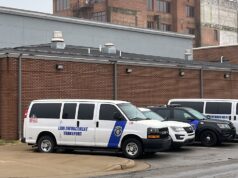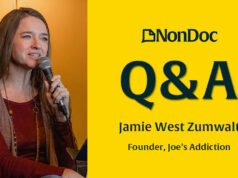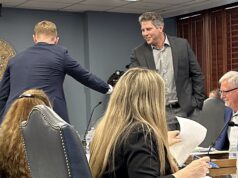On Feb. 17, nearly 10,000 Oklahoma educators gathered in the Cox Convention Center to hear Dr. Bruce Perry’s keynote address at the Oklahoma State Department of Education’s 2020 Trauma Summit.
In his two-hour presentation, Perry, a psychiatrist, explained how children who face adversity at home can bring anxiety to school, where they disrupt class when feeling threatened, or shut down, losing opportunities to learn. Educators need to understand how to help these students regulate their emotions.
Perry discussed an approach he helped develop, called “The Neurosequential Model of Therapeutics,” which emphasizes the therapeutic effect of small, accumulated positive experiences. Perry said, “Many of these moments are produced in school, where children have the opportunity to build relationships and develop a sense of regularity.” For instance, greeting a student in the hall, remembering her name, makes “a therapeutic moment.” And, “hundreds of these therapeutic moments can change a child whose life is wrought with dysfunction.”
Echoing Perry, Superintendent Joy Hofmeister said, “Having an understanding teacher, having a teacher equipped and ready to build that relationship, it can be done. And it can be done in small ways that have profound and big impacts on learning.”
It doesn’t take a brain scientist to understand that trusting and loving relationships are the key to education success, and I’m confident that the educators in attendance will benefit from the scientific background and professional development offered at the summit. In the highest poverty districts, however, I worry about over-reliance on “small ways” for building relationships to produce “big impacts on learning.”
The reality is that many teachers are not able to provide the “therapeutic moments” their students need because it takes significant institutional support and funding to facilitate those individual interactions. In the inner city, particularly, the combination of generational poverty, multiple traumas, a lack of social capital, and segregation due to suburban flight and school choice creates challenges that dwarf those in other low-income schools. Teachers in such schools face incomprehensibly large and complicated needs and behaviors, which it would take considerable resources to address.
What our poorest schools need
A former student of mine, Alexandria (as I will call her) provides an example. She was clearly brilliant. Even before she was ready to take upper-level courses, she would often sneak into senior-level classes, because she loved taking in the challenging material. She loved to engage with ideas and concepts, and her long pent-up desire to study frequently helped drive profound classroom discussions.
But, like many students at our struggling school, Alexandria would often be absent for weeks. Even when she returned to school, she was often slow to start attending class regularly. When we’d discuss her absences, she would often reply confidently that I shouldn’t worry because they would all be erased through credit-recovery worksheets or Saturday school.
Contrary to what school reformers assumed, chronically absent students like Alexandria usually didn’t miss school because they were casually cutting class. Like so many others, she faced a number of interrelated family and personal challenges that kept her out of class for extended times. It’s fair to say that her absences were largely due to what we’d call “structural barriers” to attendance.
Alexandria once showed me a photograph of her brother, a murder victim, saying that he had appeared to her last night. But before we could discuss her dream, a brawl broke loose in the hall, and she ran to join it. After that she disappeared for two months.
During that second month, I had a couple of brief conversations in the hall with another affable, chronically absent student. Soon after, he was murdered in a gang-related conflict.
Since this was during the era of school reform, the principal believed that we had to maintain an “unflinching focus” on classroom instruction, so the administration kept to a previously set professional development schedule and sent a fifth of our staff to training that would supposedly help us raise test scores. Consequently, we were on a skeleton crew in the aftermath of a homicide. Predictably, without adequate adult supervision in the cafeteria, gang fights started during lunch and spread through the building.
During a lull in the day’s chaos, Alexandria returned to school, accompanied by her grandmother. While I was meeting with them, her grandmother started having chest pains. I rushed to get the nurse, and on the way passed by a young student who was cutting class. I overheard a classmate asked him, “Did you see him die?”
“Yeah, I saw the whole thing.”
I realized that the child was my deceased student’s brother, but the possible heart attack had to take priority at that moment. I made a mental note to search for him later, but he strayed from school and I never saw him again.
Reasons for hope
In his talk, Perry was upfront about the limits of both science and school and about the fact that his Neurosequential Model and other therapies “do not capture the depth and breadth of the human experience.” To build brain health, he said, we must respect human complexity, which must be built “individually” and “in families, communities, cultures and across generations.”
But Perry is right that building the deep relationships that matter to students takes hundreds of “therapeutic moments” — in some schools, it takes thousands. And not enough teachers participate in these moments, let alone make the hundreds of parental contact attempts that are needed. But many make as many interventions as is humanly possible.
Hofmeister and the Department of Education are doing a very good thing by organizing summits and by helping to fund trauma-informed support and training. We are learning how to break cycles of poverty and trauma, but we still have a long way to go. Policy-makers should learn from Perry’s research, but they must also provide Oklahoma’s educators with the resources needed to put that research into practice.






















